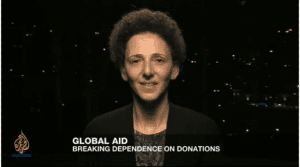Click on the image to watch the February 16, 2013 edition of Aljazeera’s “Counting the Cost.” The show is 25 minutes and focuses on aid to Palestine and Kenya. Let me know what you think!
In Jerusalem, Even the Dentist Lets You Know Who’s in Charge
This article was written for PeaceXPeace.
A lot of people hate going to the dentist because it hurts. I hate going to the dentist in Jerusalem because it hurts, but not in my mouth. It hurts my sense of belonging.
We go to an Israeli dental clinic.
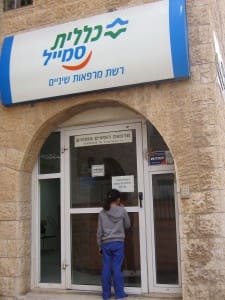 Many Palestinians in Jerusalem go to Israeli dental clinics. Why shouldn’t they? Palestinians who have residency in Jerusalem are entitled to Israeli health insurance. It’s one of the few benefits they got when Israel illegally annexed Jerusalem.
Many Palestinians in Jerusalem go to Israeli dental clinics. Why shouldn’t they? Palestinians who have residency in Jerusalem are entitled to Israeli health insurance. It’s one of the few benefits they got when Israel illegally annexed Jerusalem.
Nearly all the approximately 300,000 Palestinians living in East Jerusalem are “residents.” They were born in Jerusalem (like their parents, and their parents’ parents) but despite Israel’s annexation, they are not citizens of Israel. They have no voice in the Israeli elections that determine their fate. Not that they necessarily want to vote in the Israeli elections. But I digress.
Last time I took my children to the Israeli dental clinic, the receptionist waved us to the x-ray room and a technician hurried my middle daughter into the big faux-leather chair.
“Wait! Why does she need an x-ray?” I intervened.
The woman had straight blond hair and a pink hair extension that matched her pinkish lipstick. She looked at me with a totally unreadable look on her face.
“She’s having her teeth cleaned. She doesn’t need an x-ray,” I repeated in English. My middle daughter was looking uncomfortable in the chair, embarrassed. The other two had backed into the waiting area and were pretending not to know me.
The technician shouted to the receptionist and there was soon a small congregation of Israeli women around me, all speaking Russian. They were trying to figure out what my problem was.
The dentist herself came out from her room in the back carrying my daughter’s dental records. I could understand her Hebrew despite her heavy Russian accent, “If you want to see the dentist, you have to have an x-ray,” she proclaimed, as if it were a law of nature.
I tried to explain in my few words of Hebrew: “Teeth cleaning. Last time we came, the hygienist wrote in the file that we needed to come back.” I tapped the file in her hand. It would all be clear if she would just read the dental record.
But she didn’t. The dentist turned on her heel and walked through the reception area talking loudly. “This lady wants me to write in the file that her daughter got an x-ray but she doesn’t want her daughter to have the x-ray!”
I was livid, frustrated, powerless.
“She doesn’t need an x-ray!” I raised my voice, following her to her office.
“I decide!” she countered.
By then, all my children were ready to crawl into the medicine cabinet with shame.
And I made it worse.
I approached a Palestinian woman sitting with her children in the waiting room. I asked her in Arabic if she knew enough Hebrew to explain to “those crazy people” (yes, I was angry) that my daughter needed her teeth cleaned, not an x-ray. She didn’t look too happy to be associated with me in any way, but she stood up to help.
Then the door to the hygienist’s room opened and she stepped out, interested in all the commotion. I ran to her. Her long bouncy curls had changed colors since our last visit.
“Do you remember me?” I asked in English.
“Of course!” She smiled at my children and I felt a wave of relief. She is the reason why we go to that clinic. She makes flossing and mouthwash and fluoride fun.
“Can you please tell them I want you to clean my daughter’s teeth? I told them you wrote it on her dental record, but they don’t understand.”
A few minutes later, my middle daughter was reclining in the hygienist’s chair having her teeth cleaned.
“Apparently the person who scheduled your appointment at your last visit thought you wanted to see the dentist,” she said as she worked. “And everyone who sees the dentist for the first time needs an x-ray.”
“You provide services in Hebrew and in Russian,” I said. “Why not in Arabic? Isn’t Arabic also an official language of Israel?”
There was a pause and the hygienist looked at me, humanity shining in her eyes. She didn’t respond to me, but she spoke to my daughter. I think she said: “Spit.”
Guest post: “Northern Jerusalem or North of Jerusalem? Israel’s Land Grab in Process” by Muna Dajani
Kufr Aqab is a unique neighborhood of Jerusalem because it lies on the West Bank side of the Annexation Wall. This means that Palestinians living in Kufr Aqab can keep their rights as residents of Jerusalem but have access to Ramallah without passing through a checkpoint. It also means that the Israeli Jerusalem Municipality is responsible for all municipal functions in Kufr Aqab, although it is separated from the rest of Jerusalem by the Qalandia checkpoint. Kufr Aqab is not the only anomaly—where the legal status and geographic realities conflict—but it’s among the most important. Palestinians are fighting to keep Kufr Aqab part of Jerusalem and to keep Jerusalem part of Palestine. Nura Alkalili (Lund University), Muna Dajani (Birzeit University) and Daniela De Leo (Sapienza University Rome) conducted research to voice the realities and concerns of the voiceless Palestinians in Jerusalem, including in Kufr Aqab. Their research findings have been presented in conferences in Turkey, Argentina and Italy. In this guest post,environmental researcher and activist, Muna Dajani explains some of the complexities of life in Kufr Aqab and how residents are responding.
Israeli Sanctioned Chaos
I set out with two friends, Nura AlKhalili, an urban planner, and Daniela De Leo, an Italian professor, to research the construction boom and chaos of Kufr Aqab. Agno” between Jerusalem and Ramallah, there are shocking urban transformations in the neighborhood.
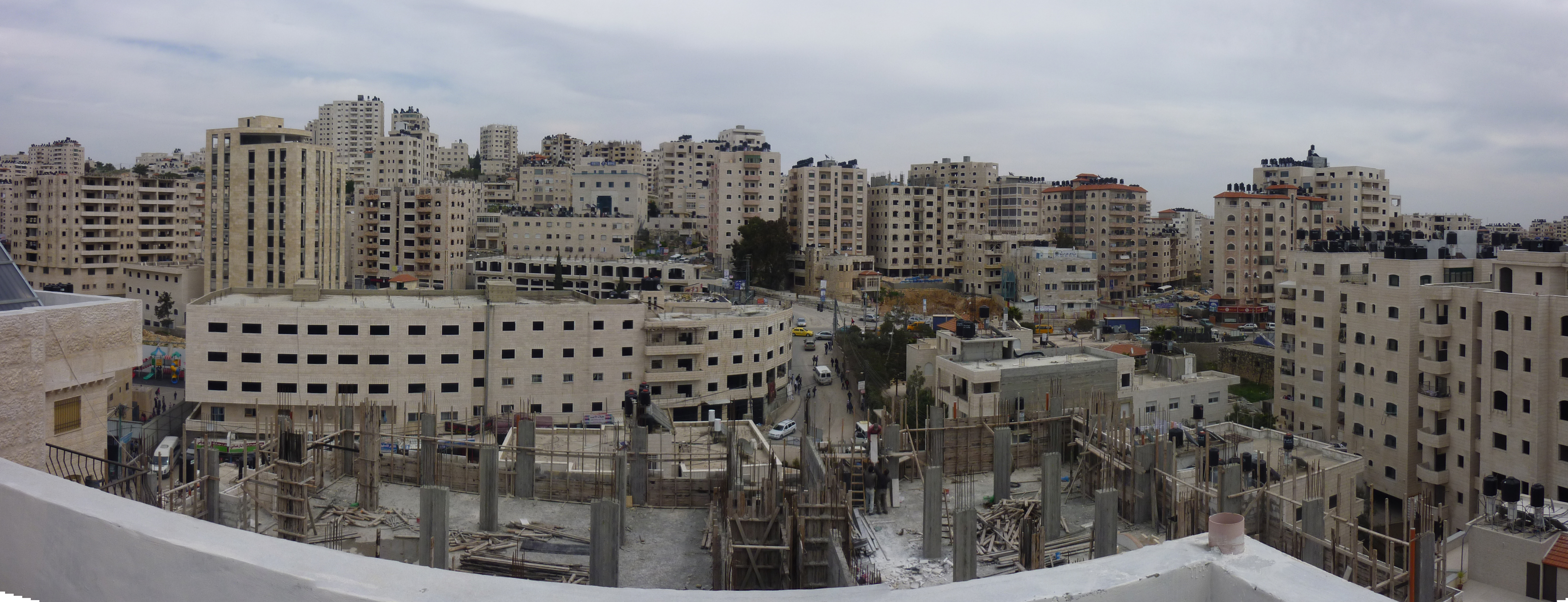
Kufr Aqab is easily identified by endless rows of towering buildings averaging ten stories high. Most are apartment blocks with commercial shops on the street level. Adjacent to each other, they threaten to fall over like dominos. The streets of Kufr Aqab are full of signs announcing vacancies and apartments for sale despite visible deficiencies: air contamination from the daily burning of garbage (because it is hardly ever collected), lack of proper water and electrical infrastructure, and streets that are not even asphalted.
The streets are overrun with cars with yellow Israeli license plates, yet none of the strict Israeli traffic laws seem to apply in Kufr Aqab. Cars drive in the opposite direction on the high-speed road and cars and trucks are parked in every direction possible. Other Israeli laws aren’t enforced either. For example, construction is booming without building permits and sometimes without the landowners’ knowledge and consent!
Despite this dark and distorted “development,” Kufr Aqab has become the temporary living solution for more than 60,000 inhabitants. Apartments in Kufr Aqab are much cheaper than a few kilometers south, thus making the area attractive to Jerusalemites who must remain within the Jerusalem municipality borders and pay taxes to Israel in order to keep their legal status. Most importantly, Jerusalemites who live in Kufr Aqab can live under the same roof with their spouses who, because they carry a Palestinian identity card, are prohibited from living in Jerusalem and can only enter by obtaining an Israeli military permit.
Being a daily traveler on the road from Jerusalem to Ramallah, and after passing the Qalandia checkpoint, I have often entered this zone where people appear so idle and passive. How can they live in Kufr Aqab under such unacceptable conditions with no sign of either opposition or civic engagement? Do they not see Israel’s systematic push of Palestinian Jerusalemites to the periphery thus disconnecting them from their center, Al Quds, and emptying the city of its residents, weakening its Arab character?
Community Activism in No Man’s Land
In our quest for answers, we met with Abu Zakariya Al Sous, an elected representative to the Jerusalem North Committee (JNC). Looking out from the window of his home, not even two meters away, lies a construction site so big that it dwarfs the old two-story building we’re in. The Jerusalem North Committee replaced the Israeli-run community center, one of those that are inserted in every Palestinian neighborhood of East Jerusalem and which slowly but steadily impose their own ‘Israelization’ agendas on Palestinian residents, adding to their identity crisis.
Abu Zakariya has been an active resident of Kufr Aqab since long before the construction boom that infected the area one decade ago. Abu Zakariya stressed that “Jerusalem North” is symbolically and strategically important because Israel has relentlessly tried to label Kufr Aqab as an area North of Jerusalem (that is, an area that does not belong to the municipal boundaries of the city of Jerusalem)thus disconnecting it from its historical significance as a suburb of Jerusalem. By doing so, the Israeli Jerusalem Municipality tries to create new facts on the ground, implying that its responsibilities stop at the first cement section of the Annexation Wall, leaving Kufr Aqab and its 60,000 Jerusalemite residents to fend for themselves in terms of acquiring rights to proper infrastructure, education, health services, public facilities, and their own security.
The JNC is composed of 12 volunteer members and its main objectives are advocating for and reclaiming full rights for Palestinians in the North of Jerusalem from the Jerusalem Municipality to whom they pay taxes. Abu Zakariya explained the complexity of mobilizing Kufr Aqab residents to challenge the political, social, health and environmental problems that haunt them. JNC decided to use legal means to fight against the problems that most affect people’s daily lives and to build momentum for positive change. For example, in June 2011, the JNC filed a lawsuit against the waste collection department at the Jerusalem Municipality and the Ministry of Environmental Protection. They demanded a clean environment free from diseases that have emerged recently due to the continuous burning of uncollected garbage. In 2012, the court ruled that the Municipality must submit a plan to improve services in Kufr Aqab. Since then, seventy new large garbage bins have been delivered to the neighborhood with an additional 110 smaller bins distributed on the side roads and thirty additional collection trucks operate on a weekly basis.
This is a success on all levels for the Jerusalem North Committee and the Palestinian communities of Jerusalem, as it sets a precedent and encourages use of legal measures for Jerusalemites to reclaim their rights as residents of the city. The JNC is now demanding proper infrastructure from the Israeli phone company, Bezeq, and advocating for more schools and public spaces.
Abu Zakariya added: “We are not asking for charity. We have lived for generations in this city and we have rights. We will not stop demanding our rights—from the basic demand for garbage-free neighborhoods to our biggest demand: equality, stability and prosperity for Palestinian Jerusalemites in Al Quds.”
Stolen Books, Stolen Identity: What Did Israel Do with Palestinians’ Literary Heritage?
This story was originally published by Arabic Literature in English.
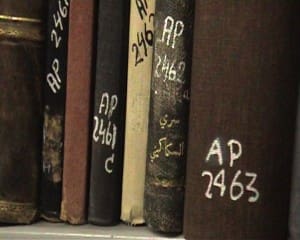 The camera follows two Palestinians with Israeli citizenship from the counter at Israel’s National Library to a table. They carry a small stack books from a collection labeled “AP” for “Absentee Property.” They sit awestruck in front of the books. They touch covers showing respect for the books, their rightful owners, and the Nakba that caused Palestinians to lose their country and heritage.
The camera follows two Palestinians with Israeli citizenship from the counter at Israel’s National Library to a table. They carry a small stack books from a collection labeled “AP” for “Absentee Property.” They sit awestruck in front of the books. They touch covers showing respect for the books, their rightful owners, and the Nakba that caused Palestinians to lose their country and heritage.
One of the Palestinians opens a book and finds “Khalil Sakakini” written by hand in the inside cover. He gasps. The audience watching the film, crammed into the basement floor of Educational Bookshop on Salah Al-Din Street in Jerusalem, is captivated. I crane my neck to see past the tall woman in front of me. The importance of this book, a one-time possession of one of the Arab world’s most important educators and nationalists, jumps off the screen. I feel an unspoken sadness in the room as we grasp the reality: This priceless piece of Palestinian heritage, and so many others, is held by Israel’s National Library.
This scene is one of many gripping scenes in the film, “The Great Book Robbery” shown for the first time in Palestine on January 12, 2013 to an audience of almost 150 people. The documentary by Israeli-Dutch director Benny Brunner unfolds the story of at least 70,000 books looted from Palestinian homes and institutions in 1948. Benny Brunner, a longtime maker of films says of himself: “His work is subversive in nature and has proven to be a thorn in the collective Israeli establishment’s backside.”
It is widely known that when approximately 750,000 Palestinians were expelled or fled from Palestine before and after the establishment of Israel, most Palestinian land and belongings were lost. This film, however, highlights the plight of books. It’s a story that isn’t well-known, and to lovers of books, it is particularly tragic.
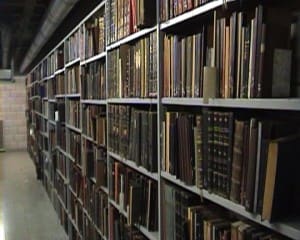 According to the film, Gish Amit, a PhD student at the time (2005-9), stumbled by accident upon Israeli documents attesting to the “collection” of Palestinian books in 1948 as he was writing his dissertation about archives. Among papers preserved at the National Library, he found detailed documentation about approximately 30,000 Palestinian books that were taken from private homes and institutions in Jerusalem, by staff of the National Library in coordination with the army. In an article originally published in Haaretz, Amit commented on the fact that documentation of the theft was found in the Library itself. He said, ““It is the paradoxical structure of any archive: the place that preserves the power and organizes it is also the place that exposes the violence and wrongdoing. In this respect, the archive is a place that undermines itself.”
According to the film, Gish Amit, a PhD student at the time (2005-9), stumbled by accident upon Israeli documents attesting to the “collection” of Palestinian books in 1948 as he was writing his dissertation about archives. Among papers preserved at the National Library, he found detailed documentation about approximately 30,000 Palestinian books that were taken from private homes and institutions in Jerusalem, by staff of the National Library in coordination with the army. In an article originally published in Haaretz, Amit commented on the fact that documentation of the theft was found in the Library itself. He said, ““It is the paradoxical structure of any archive: the place that preserves the power and organizes it is also the place that exposes the violence and wrongdoing. In this respect, the archive is a place that undermines itself.”
Only about 6,000 books are still labeled “Absentee Property”—and these, we were told, can be seen by logging into the National Library of Israel and searching by call numbers starting with AP. Brunner speculates that the other 24,000 books that are listed in the documentation are either mixed in with the general collection or have been lost or destroyed. Another 50,000-60,000 books are known to have been looted from other parts of Palestine, mostly textbooks, which Brunner speculated were mostly destroyed or sold. During the discussion that followed the filom, he also made the point that rare manuscripts (estimated by a knowledgeable member of the audience as numbering around 50,000 originating from 56 libraries in and around Jerusalem) are not included in the estimates and are totally unaccounted for. There are rare Palestinian manuscripts in the collection at the National Library, but they are not accessible by the general public. There are also rare Palestinian manuscripts at Hebrew University. “We should remember,” Brunner added, “the film only addresses books that were stolen in 1948. We don’t know the details of what happened in 1967, though we do know there is a pattern of Israeli looting of Palestinian books, photographs and archives, including the PLO archives in Lebanon.”
To prove this point, a member of the audience later told me that a rare copy of Palestine in Pictures from the early 1920s was confiscated by the Israelis when her father crossed Allenby Bridge from Jordan in 1987 after he waited five hours to get it back. He finally asked for and was given a receipt for his book, but as history proves, documentation does not necessarily lead to restitution. The only other copy the owner knows of is in Bodlian Library at Oxford University
The Great Book Robbery, which took five years to make, was broadcast by Aljazeera English and seen in fifty countries, and has also been screened in the three major cinemas in Israel. The director has so far been unable to arrange a showing on Israeli television. Apparently, there is some controversy over whether the original intention was to protect the books or to steal them, but regardless of the original intent, the Israel National Library, in cooperation with the Israeli Custodian of Abandoned Property has kept Palestinian private property for over 64 years and made no effort to return it to its rightful owners. In fact, according to Benny Brunner, until the 1950, each card in the catalogue listed the book with a code that linked it to the place where it came from, thus identifying the original owner. However, those codes were erased in the late 1950s.

Those who watched The Great Book Robbery that night were visibly moved. The film showed the vibrancy of Palestinian literary and cultural life before 1948, how it was stolen (with poignant quotes by a Palestinian prisoner of war who was forced to take part in looting his own village), and the impact on Palestinian identity and well-being today. Many seemed inspired by the movie’s concluding slide which noted that: 1) no effort has been made by Israel to return the stolen books; 2) nor has there been any organized effort by Palestinians to claim them.
* Should there be a national effort by Palestinians to reclaim books stolen in 1948 and since?
* What Palestinian entity is the best custodian for these national treasures?
* Would a successful claim on books strengthen the Palestinian claim on other stolen property or would a piecemeal approach starting with books weaken the Palestinian national movement for self-determination and reparations on a broader scale?
- « Previous Page
- 1
- …
- 37
- 38
- 39
- 40
- 41
- …
- 61
- Next Page »
